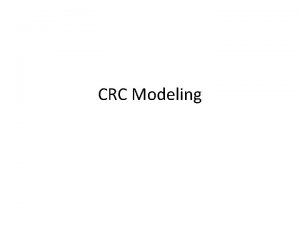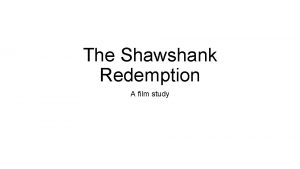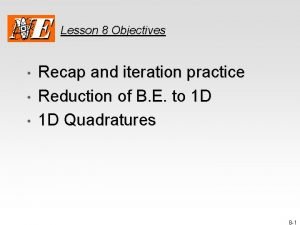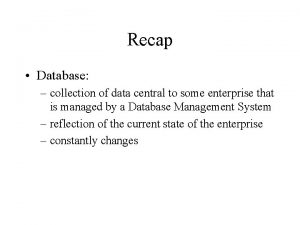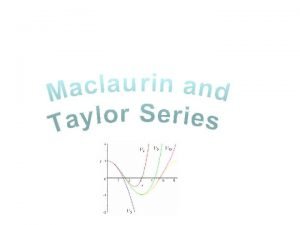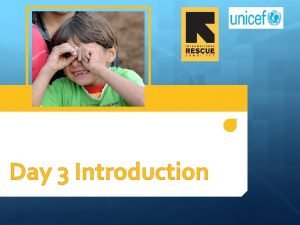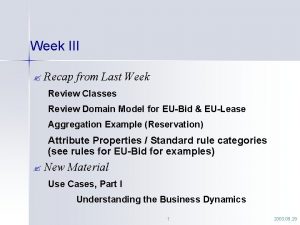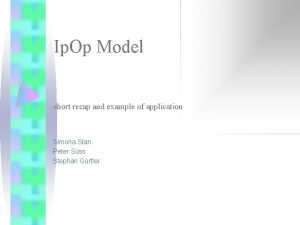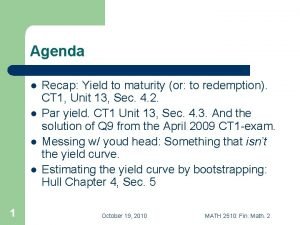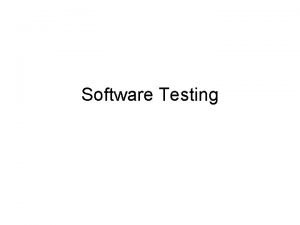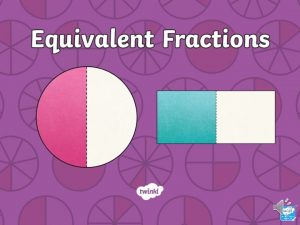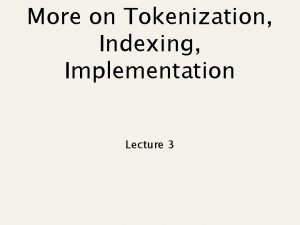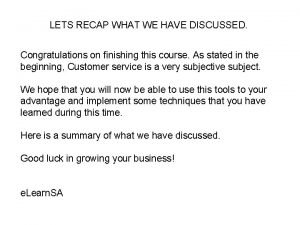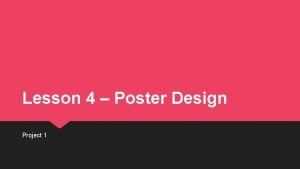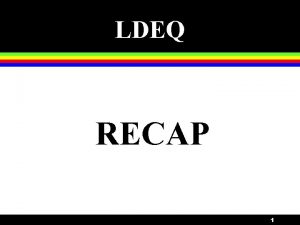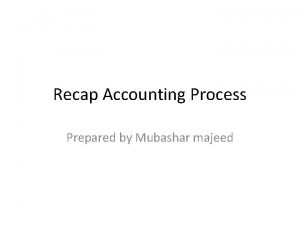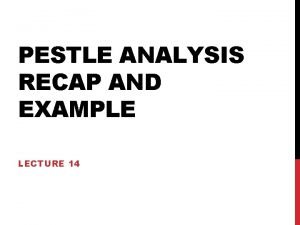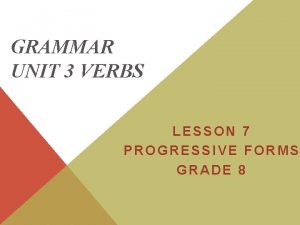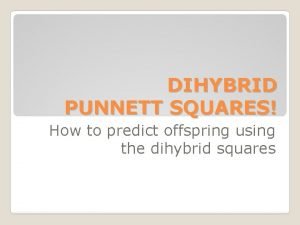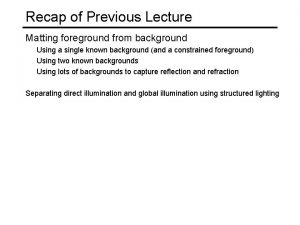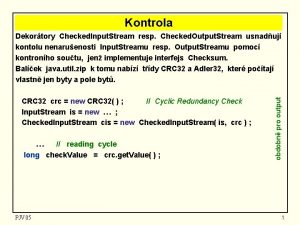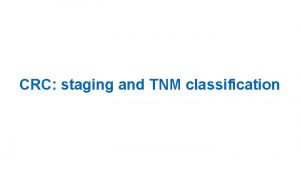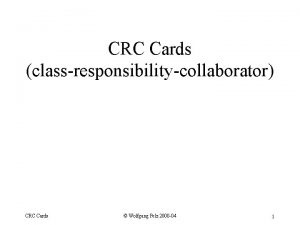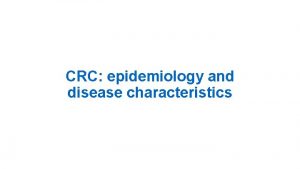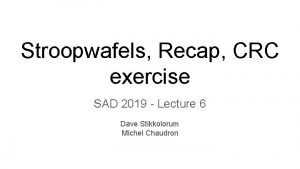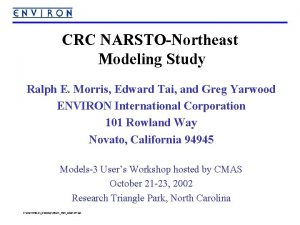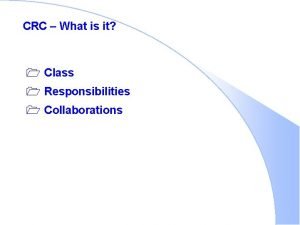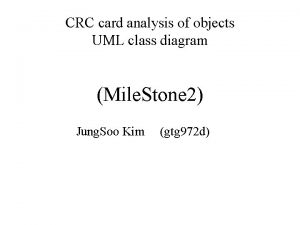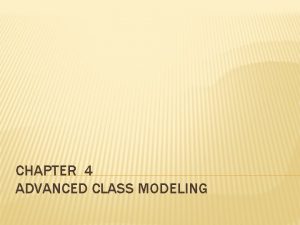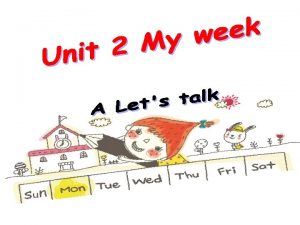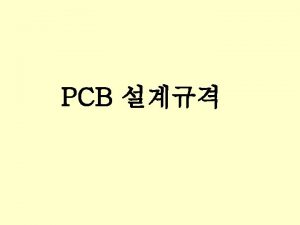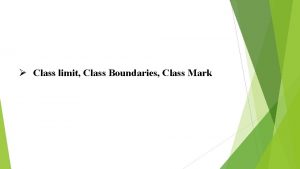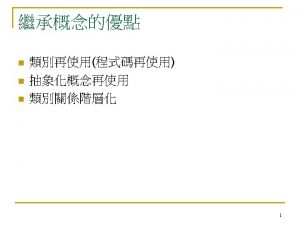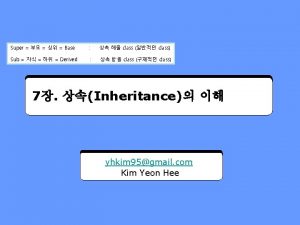CRC Modeling Recap Class Modeling How to Identify


































- Slides: 34

CRC Modeling

Recap • Class Modeling – How to Identify classes, its attributes and functions? – Class selection criteria – Relationships • Associations • Generalization

Content • Class Modeling – Relationships • Dependency • Realization – Constraints, Notes • CRC Modeling

Associations (cont. ) Role name Staff. Member instructor 1. . * Multiplicity Association name instructs * Navigable (uni-directional) association Student Role * Courses Reflexive association pre requisites 0. . 3 4

Aggregation • A special form of association that models a wholepart relationship between an aggregate (the whole) and its parts. – Models a “is a part-part of” relationship. 2. . * Car Whole Door 1. . * House Part 5

Aggregation (cont. ) • Aggregation tests: – Is the phrase “part of” used to describe the relationship? • A door is “part of” a car – Are some operations on the whole automatically applied to its parts? • Move the car, move the door. – Are some attribute values propagated from the whole to all or some of its parts? • The car is blue, therefore the door is blue. – Is there an intrinsic asymmetry to the relationship where one class is subordinate to the other? • A door is part of a car. A car is not part of a door. UML Class Diagrams 6

Composition • A strong form of aggregation – The whole is the sole owner of its part. • The part object may belong to only one whole – Multiplicity on the whole side must be zero or one. – The life time of the part is dependent upon the whole. • The composite must manage the creation and destruction of its parts. Circle Polygon 1 Point 3. . * Circle Point 7

Generalization • Indicates that objects of the specialized class (subclass) are substitutable for objects of the generalized class (super-class). – “is kind of” relationship. {abstract} is a tagged value that indicates that the class is abstract. The name of an abstract class should be italicized An abstract class Shape {abstract} Generalization relationship Circle Super Class Sub Class 8

Generalization • A sub-class inherits from its super-class – Attributes – Operations – Relationships • A sub-class may – Add attributes and operations – Add relationships – Refine (override) inherited operations • A generalization relationship may not be used to model interface implementation. 9

Dependency • A dependency indicates a semantic relation between two or more classes in which a change in one may force changes in the other although there is no explicit association between them. • A stereotype may be used to denote the type of the dependency. Iterator <<friend>> Vector 10

Realization • A realization relationship indicates that one class implements a behavior specified by another class (an interface or protocol). • An interface can be realized by many classes. • A class may realize many interfaces. Linked. List <<interface>> List UML Class Diagrams Linked. List 11

Constraint Rules and Notes • Constraints and notes annotate among other things associations, attributes, operations and classes. • Constraints are semantic restrictions noted as Boolean expressions. – UML offers many pre-defined constraints. Customer id: long { value > 0 } 1 * { total < $50 } Constraint Order may be canceled Note UML Class Diagrams 12

Examples

Examples Reference: www. smartdraw. com

CRC Cards • A CRC card is divided into three sections (Beck & Cunningham, 1989; Ambler, 1995)

Responsibilities and Collaborations • A responsibility is anything that a class knows or does. • Sometimes a class will have a responsibility to fulfill, but will not have enough information to do it. When this happens it has to collaborate with other classes to get the job done.

CRC Model • A CRC model is a collection of CRC cards that represent whole or part of an application or problem domain. • The most common use for CRC models is to gather and define the user requirements for an object-oriented application. • Collaborating cards are placed close to each other


Creating CRC Model 1. 2. 3. 4. 5. 6. Put together the CRC modeling team. Organize the modeling room. Do some brainstorming. Explain the CRC modeling technique. Iteratively perform the steps of CRC modeling. Perform use-case scenario testing.

CRC Team • • Business Domain Experts (BDEs). Facilitator. Scribe(s). Observers.

Room preparation • Reserve a meeting room that has something write on. • Bring CRC modeling supplies. • Have a modeling table • Have chairs and desks for the scribe(s). • Have chairs for the BDEs. • Have chairs for the observers

Brainstorming Set of questions: • • • Who is this system for? What will they do with the system? Why do we do this the way that we do? What business needs does this system support? What do/will our customers want/demand from us? How is the business changing? What is our competition doing? Why? How can we do it better? Do we even need to do this? If we were starting from scratch, how would we do this? Just because we were successful in the past doing this, will we be successful in the future?

Brainstorming (cont…) • • • • Can we combine several jobs into one? Do we want to? How will people’s jobs be affected? Are we empowering or disempowering them? What information will people need to do their jobs? Is work being performed where it makes the most sense? Are there any trivial tasks that we can automate? Are people performing only the complex tasks that the system can’t handle? Will the system pay for itself? Does the system support teamwork, or does it hinder it? Do our users have the skills/education necessary to use this system? What training will they need? What are our organization’s strategic goals and objectives? Does this system support them? How can we do this faster? How can we do this cheaper? How can we do this better?

Explain the CRC Modeling Technique • Facilitator should describe the CRC modeling process. This usually takes between ten and fifteen minutes and will often include the creation of several example CRC cards. • Lead BDEs through creation of example CRC cards

Perform The Iterative Steps of CRC Modeling • Find classes – – – – – Look for anything that interacts with the system, or is part of the system Ask yourself “Is there a customer? ” Follow the money Look for reports generated by the system Look for any screens used in the system Immediately prototype interface and report classes Look for the three to five main classes right away Create a new card for a class immediately Use one or two words to describe the class Class names are singular

• Find responsibilities – – – Ask yourself what the class knows Ask yourself what the class does If you’ve identified a responsibility, ask yourself what class it "belongs" to Sometimes get responsibilities that we won’t implement, and that’s OK Classes will collaborate to fulfill many of their responsibilities • Define collaborators – Collaboration occurs when a class needs information that it doesn’t have – Collaboration occurs when a class needs to modify information that it doesn’t have – There will always be at least one initiator of any given collaboration – Sometimes the collaborator does the bulk of the work – Don’t pass the buck – New responsibilities may be created to fulfill the collaboration

• Define use-cases – The BDEs will identify them as responsibilities of actor classes – Do some brainstorming – Transcribe the scenarios onto cards • Arrange the cards on the table – Cards that collaborate with each other should be close to one another on the desk – The more that two cards collaborate, the closer that they should be on the desk – Expect to be moving the cards around a lot at the beginning – Put "busy" cards towards the center of the table – Actually move them around – People will identify relationships/associations between classes as they move them around

Perform Use-Case Scenario Testing • • • Call out a new scenario Determine which card should handle the responsibility Update the cards whenever necessary Describe the processing logic Collaborate if necessary Pass the ball back when done

How CRC Modeling Fits in?

CRC Modeling Tips and Techniques • • • Send ahead an agenda a few days before the modeling session Prominently display the CRC definitions Use their terminology Keep it low tech Expect to prototype Expect to take a few days Get management support Include CRC modeling in your system development life cycle Do CRC modeling with front-line staff only

Advantages of CRC Modeling • • The experts do the analysis User participation increased Breaks down communication barriers It’s simple and straightforward It’s non-threatening to users It’s inexpensive and portable It goes hand-in-hand with prototyping It leads directly into class diagramming

Disadvantages of CRC Modeling • It’s threatening to some developers • It’s hard to get users together • CRC cards are limited

Summary • Class Diagrams • CRC Modeling

Reference Ambler, S. W. , (1998) CRC Modelling: Bridging the Communication Gap Between Developers and Users, An Amby. Soft Inc. White Paper
 Crc modeling
Crc modeling Modeling role modeling theory
Modeling role modeling theory Relational vs dimensional data modeling
Relational vs dimensional data modeling Shawshank redemption brief summary
Shawshank redemption brief summary Does nick like gatsby chapter 8
Does nick like gatsby chapter 8 What is price matching
What is price matching What is the purpose of an iteration recap
What is the purpose of an iteration recap Recap intensity clipping
Recap intensity clipping 60 minutes recap
60 minutes recap Recap database
Recap database Bracket power rule
Bracket power rule Recap introduction
Recap introduction Recap introduction
Recap introduction Recap from last week
Recap from last week Act 1 discussion questions the crucible
Act 1 discussion questions the crucible Pontius pilate allusion
Pontius pilate allusion Logbook recap example
Logbook recap example Ytm recap
Ytm recap Black box recap
Black box recap Fractions recap
Fractions recap Recap
Recap The horizontal axis in the coordinate plane.
The horizontal axis in the coordinate plane. Recap indexing scans
Recap indexing scans Let's have a quick recap
Let's have a quick recap Recap poster
Recap poster What is an essay
What is an essay Ldeq recap
Ldeq recap Pee paragraph romeo and juliet
Pee paragraph romeo and juliet Recap accounting
Recap accounting What is economic environment example
What is economic environment example Let's recap
Let's recap Let's recap
Let's recap Foil method punnett squares
Foil method punnett squares Recap background
Recap background Realism vs anti realism
Realism vs anti realism
